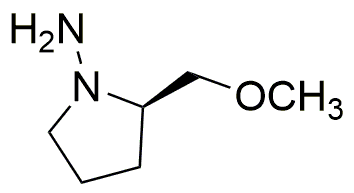(R)-(+)-1-Amino-2-(methoxymethyl)pyrrolidine is widely utilized in research focused on
- Pharmaceutical Development: This compound serves as a key intermediate in the synthesis of various pharmaceuticals, particularly those targeting neurological disorders. Its unique structure allows for enhanced bioactivity compared to other similar compounds.
- Chiral Synthesis: As a chiral building block, it plays a crucial role in asymmetric synthesis, helping chemists create enantiomerically pure compounds that are essential for drug efficacy.
- Material Science: It is used in the development of advanced materials, particularly in the creation of polymers that require specific mechanical properties, benefiting industries like automotive and aerospace.
- Biochemical Research: This compound is valuable in studying receptor interactions and enzyme activities, aiding researchers in understanding biological processes and developing new therapeutic strategies.
- Agrochemical Applications: It can be utilized in the formulation of agrochemicals, enhancing the effectiveness of pesticides and herbicides, which is crucial for improving crop yields and sustainability.
General Information
Properties
Safety and Regulations
Applications
(R)-(+)-1-Amino-2-(methoxymethyl)pyrrolidine is widely utilized in research focused on
- Pharmaceutical Development: This compound serves as a key intermediate in the synthesis of various pharmaceuticals, particularly those targeting neurological disorders. Its unique structure allows for enhanced bioactivity compared to other similar compounds.
- Chiral Synthesis: As a chiral building block, it plays a crucial role in asymmetric synthesis, helping chemists create enantiomerically pure compounds that are essential for drug efficacy.
- Material Science: It is used in the development of advanced materials, particularly in the creation of polymers that require specific mechanical properties, benefiting industries like automotive and aerospace.
- Biochemical Research: This compound is valuable in studying receptor interactions and enzyme activities, aiding researchers in understanding biological processes and developing new therapeutic strategies.
- Agrochemical Applications: It can be utilized in the formulation of agrochemicals, enhancing the effectiveness of pesticides and herbicides, which is crucial for improving crop yields and sustainability.
Documents
Safety Data Sheets (SDS)
The SDS provides comprehensive safety information on handling, storage, and disposal of the product.
Product Specification (PS)
The PS provides a comprehensive breakdown of the product’s properties, including chemical composition, physical state, purity, and storage requirements. It also details acceptable quality ranges and the product's intended applications.
Certificates of Analysis (COA)
Search for Certificates of Analysis (COA) by entering the products Lot Number. Lot and Batch Numbers can be found on a product’s label following the words ‘Lot’ or ‘Batch’.
*Catalog Number
*Lot Number
Certificates Of Origin (COO)
This COO confirms the country where the product was manufactured, and also details the materials and components used in it and whether it is derived from natural, synthetic, or other specific sources. This certificate may be required for customs, trade, and regulatory compliance.
*Catalog Number
*Lot Number
Safety Data Sheets (SDS)
The SDS provides comprehensive safety information on handling, storage, and disposal of the product.
DownloadProduct Specification (PS)
The PS provides a comprehensive breakdown of the product’s properties, including chemical composition, physical state, purity, and storage requirements. It also details acceptable quality ranges and the product's intended applications.
DownloadCertificates of Analysis (COA)
Search for Certificates of Analysis (COA) by entering the products Lot Number. Lot and Batch Numbers can be found on a product’s label following the words ‘Lot’ or ‘Batch’.
*Catalog Number
*Lot Number
Certificates Of Origin (COO)
This COO confirms the country where the product was manufactured, and also details the materials and components used in it and whether it is derived from natural, synthetic, or other specific sources. This certificate may be required for customs, trade, and regulatory compliance.


